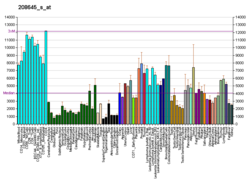40S ribosomal protein S14
| RPS14 | |||||||||||||||||||||||||||||||||||||||||||||||||||
|---|---|---|---|---|---|---|---|---|---|---|---|---|---|---|---|---|---|---|---|---|---|---|---|---|---|---|---|---|---|---|---|---|---|---|---|---|---|---|---|---|---|---|---|---|---|---|---|---|---|---|---|
| |||||||||||||||||||||||||||||||||||||||||||||||||||
| Identifiers | |||||||||||||||||||||||||||||||||||||||||||||||||||
| Aliases | RPS14, EMTB, S14, ribosomal protein S14 | ||||||||||||||||||||||||||||||||||||||||||||||||||
| External IDs | OMIM: 130620; MGI: 98107; HomoloGene: 90926; GeneCards: RPS14; OMA:RPS14 - orthologs | ||||||||||||||||||||||||||||||||||||||||||||||||||
| |||||||||||||||||||||||||||||||||||||||||||||||||||
| |||||||||||||||||||||||||||||||||||||||||||||||||||
| |||||||||||||||||||||||||||||||||||||||||||||||||||
| |||||||||||||||||||||||||||||||||||||||||||||||||||
| |||||||||||||||||||||||||||||||||||||||||||||||||||
| Wikidata | |||||||||||||||||||||||||||||||||||||||||||||||||||
| |||||||||||||||||||||||||||||||||||||||||||||||||||
40S ribosomal protein S14 is a protein that in humans is encoded by the RPS14 gene.[5][6][7]
Ribosomes, the organelles that catalyze protein synthesis, consist of a small 40S subunit and a large 60S subunit. Together these subunits are composed of 4 RNA species and approximately 80 structurally distinct proteins. This gene encodes a ribosomal protein that is a component of the 40S subunit. The protein belongs to the S11P family of ribosomal proteins. It is located in the cytoplasm. Transcript variants utilizing alternative transcription initiation sites have been described in the literature. As is typical for genes encoding ribosomal proteins, there are multiple processed pseudogenes of this gene dispersed through the genome. In Chinese hamster ovary cells, mutations in this gene can lead to resistance to emetine, a protein synthesis inhibitor.[7]
References
- ^ a b c GRCh38: Ensembl release 89: ENSG00000164587 – Ensembl, May 2017
- ^ a b c GRCm38: Ensembl release 89: ENSMUSG00000024608 – Ensembl, May 2017
- ^ "Human PubMed Reference:". National Center for Biotechnology Information, U.S. National Library of Medicine.
- ^ "Mouse PubMed Reference:". National Center for Biotechnology Information, U.S. National Library of Medicine.
- ^ Rhoads DD, Dixit A, Roufa DJ (Jan 1987). "Primary structure of human ribosomal protein S14 and the gene that encodes it". Mol Cell Biol. 6 (8): 2774–83. doi:10.1128/mcb.6.8.2774. PMC 367844. PMID 3785212.
- ^ Diaz JJ, Roufa DJ (Apr 1992). "Fine-structure map of the human ribosomal protein gene RPS14". Mol Cell Biol. 12 (4): 1680–6. doi:10.1128/mcb.12.4.1680. PMC 369611. PMID 1549121.
- ^ a b "Entrez Gene: RPS14 ribosomal protein S14".
Further reading
- Wool IG, Chan YL, Glück A (1996). "Structure and evolution of mammalian ribosomal proteins". Biochem. Cell Biol. 73 (11–12): 933–47. doi:10.1139/o95-101. PMID 8722009.
- Chen IT, Dixit A, Rhoads DD, Roufa DJ (1986). "Homologous ribosomal proteins in bacteria, yeast, and humans". Proc. Natl. Acad. Sci. U.S.A. 83 (18): 6907–11. Bibcode:1986PNAS...83.6907C. doi:10.1073/pnas.83.18.6907. PMC 386619. PMID 3529092.
- Dana S, Wasmuth JJ (1983). "Selective linkage disruption in human-Chinese hamster cell hybrids: deletion mapping of the leuS, hexB, emtB, and chr genes on human chromosome 5". Mol. Cell. Biol. 2 (10): 1220–8. doi:10.1128/mcb.2.10.1220. PMC 369921. PMID 7177110.
- Tasheva ES, Roufa DJ (1995). "Regulation of human RPS14 transcription by intronic antisense RNAs and ribosomal protein S14". Genes Dev. 9 (3): 304–16. doi:10.1101/gad.9.3.304. PMID 7867928.
- Matoba R, Okubo K, Hori N, et al. (1994). "The addition of 5'-coding information to a 3'-directed cDNA library improves analysis of gene expression". Gene. 146 (2): 199–207. doi:10.1016/0378-1119(94)90293-3. PMID 8076819.
- Vladimirov SN, Ivanov AV, Karpova GG, et al. (1996). "Characterization of the human small-ribosomal-subunit proteins by N-terminal and internal sequencing, and mass spectrometry". Eur. J. Biochem. 239 (1): 144–9. doi:10.1111/j.1432-1033.1996.0144u.x. PMID 8706699.
- Martin-Nieto J, Roufa DJ (1997). "Functional analysis of human RPS14 null alleles". J. Cell Sci. 110 (8): 955–63. doi:10.1242/jcs.110.8.955. hdl:10045/9720. PMID 9152021.
- Kenmochi N, Kawaguchi T, Rozen S, et al. (1998). "A map of 75 human ribosomal protein genes". Genome Res. 8 (5): 509–23. doi:10.1101/gr.8.5.509. PMID 9582194.
- Strausberg RL, Feingold EA, Grouse LH, et al. (2003). "Generation and initial analysis of more than 15,000 full-length human and mouse cDNA sequences". Proc. Natl. Acad. Sci. U.S.A. 99 (26): 16899–903. Bibcode:2002PNAS...9916899M. doi:10.1073/pnas.242603899. PMC 139241. PMID 12477932.
- Colland F, Jacq X, Trouplin V, et al. (2004). "Functional proteomics mapping of a human signaling pathway". Genome Res. 14 (7): 1324–32. doi:10.1101/gr.2334104. PMC 442148. PMID 15231748.
- Gerhard DS, Wagner L, Feingold EA, et al. (2004). "The status, quality, and expansion of the NIH full-length cDNA project: the Mammalian Gene Collection (MGC)". Genome Res. 14 (10B): 2121–7. doi:10.1101/gr.2596504. PMC 528928. PMID 15489334.
- Yu Y, Ji H, Doudna JA, Leary JA (2005). "Mass spectrometric analysis of the human 40S ribosomal subunit: native and HCV IRES-bound complexes". Protein Sci. 14 (6): 1438–46. doi:10.1110/ps.041293005. PMC 2253395. PMID 15883184.
- Rual JF, Venkatesan K, Hao T, et al. (2005). "Towards a proteome-scale map of the human protein-protein interaction network". Nature. 437 (7062): 1173–8. Bibcode:2005Natur.437.1173R. doi:10.1038/nature04209. PMID 16189514. S2CID 4427026.
- Lim J, Hao T, Shaw C, et al. (2006). "A protein-protein interaction network for human inherited ataxias and disorders of Purkinje cell degeneration". Cell. 125 (4): 801–14. doi:10.1016/j.cell.2006.03.032. PMID 16713569. S2CID 13709685.
- Ewing RM, Chu P, Elisma F, et al. (2007). "Large-scale mapping of human protein-protein interactions by mass spectrometry". Mol. Syst. Biol. 3 (1): 89. doi:10.1038/msb4100134. PMC 1847948. PMID 17353931.
- v
- t
- e
| Initiation factor |
| ||||||||||||||||||||
|---|---|---|---|---|---|---|---|---|---|---|---|---|---|---|---|---|---|---|---|---|---|
| Elongation factor |
| ||||||||||||||||||||
| Release factor | |||||||||||||||||||||
| Ribosomal Proteins |
|
 | This article on a gene on human chromosome 5 is a stub. You can help Wikipedia by expanding it. |
- v
- t
- e


















